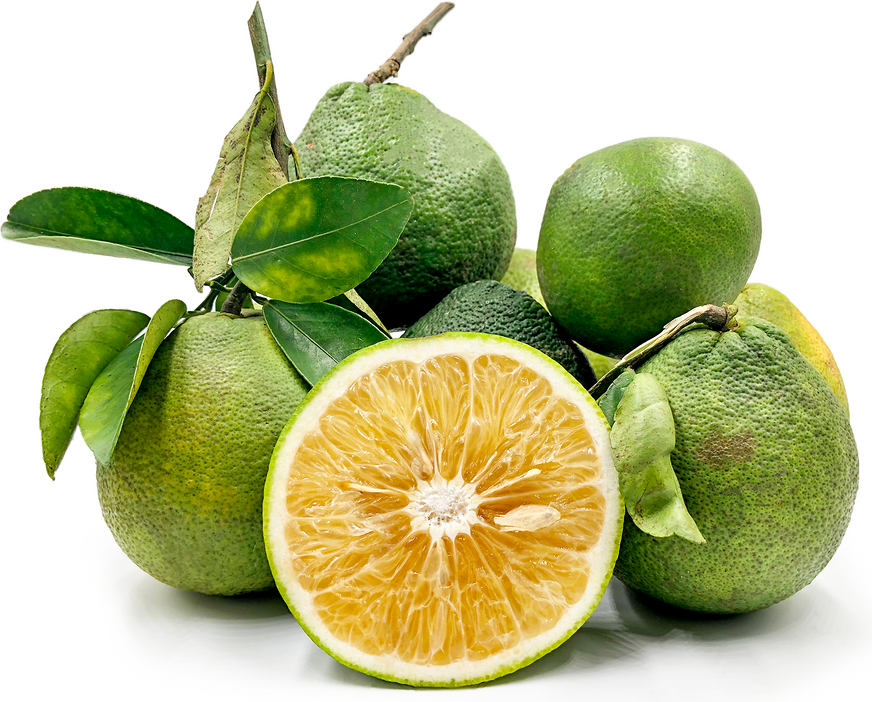


Limau Bali
Estimated Inventory, lb : 0
Description/Taste
Limau Bali fruits are medium to large in size and are oblate, round, or pear-shaped, averaging 10-30 centimeters in diameter. The green skin ranges from a thin to a medium-thickness and is bumpy, soft, and covered in oil glands and pores. Below the skin, the albedo, or white pith is tightly attached to the skin, is spongy, and encases the segmented flesh. The light orange to pale pink, semi-translucent flesh is somewhat juicy, contains a few large cream-colored seeds, and is divided into 16-18 segments. Limau Bali fruits are dense, aromatic, and sweet with mild acidity.
Seasons/Availability
Limau Bali fruits are seasonally available in Southeast Asia in the late summer through fall. They are also available again for a shorter season in the late winter through early spring.
Current Facts
Limau Bali, botanically classified as Citrus maxima, is a local Southeast Asian name for pomelos, or large citrus fruits that belong to the Rutaceae family and grow on trees that average 5-15 meters in height. Also known as Limau Besar, Limau Tambun, Limau Abong, Limau Jambua, Pummelo, Chinese grapefruit, Bali Lemon, and Shaddock, Limau Bali fruits are native to tropical Asia and are one of the original citrus species that many varieties such as the grapefruit and orange are derived from. Commonly found at local markets, Limau Bali fruits are widely cultivated and are also grown in backyard gardens. Limau Bali fruits are predominantly used for fresh eating, and their rinds are commonly candied, used as flavoring, or are burned as a natural mosquito repellent.
Nutritional Value
Limau Bali fruits are a good source of vitamin C, potassium, calcium, iron, and vitamins A and B.
Applications
Limau Bali fruits are best suited for raw applications as they can easily be peeled and consumed fresh out of hand, mixed in with green salads, or tossed in with stir-fries for a mild citrus flavoring. They can also be candied or boiled to make marmalade, jellies, syrups, or jams. The peels are not edible but are used for flavoring in culinary applications such as sweet soups and desserts. Limau Bali fruits pair well with coconut, pineapple, mango, yogurt, peanuts, chile, basil, mint, onions, garlic, and shellfish like shrimp and scallops. They will keep up to one week when stored in the refrigerator but should be used immediately for optimum flavor.
Ethnic/Cultural Info
Pomelos are highly valued in Asia, especially in Malaysia and China. In Ipoh, a highly populated city in Malaysia, pomelos are one of the top fresh fruits sold at markets and are often given their own display, section, and price separate from the rest of the produce. They are also sold in markets outside of temples and along many high traffic roads. There is even a statue of a pomelo in town and pomelo farms where visitors can tour the grounds to learn about the cultivation process and pick out their own fruit. In China, pomelos are commonly consumed during the Chinese New Year as they are a symbol for prosperity and good fortune in the year to come.
Geography/History
Limau Bali fruits are native to Southeast Asia, especially in Malaysia, Fiji, and Indonesia, and have been growing in the wild since ancient times. They were believed to have spread to China in 100 BCE and have since been cultivated in Southern China. Today Limau Bali fruits are found in local markets in Fiji, Malaysia, Thailand, India, Japan, China, Taiwan, India, New Guinea, and Tahiti. The Limau Bali fruit in the photo above was taken at the MJC Night Market in Kuching, Borneo.
Recipe Ideas
Recipes that include Limau Bali. One
| Kuali |
|
Kerabu Limau Bali |
| Upper Crust |
|
Malaysian calamari salad |




